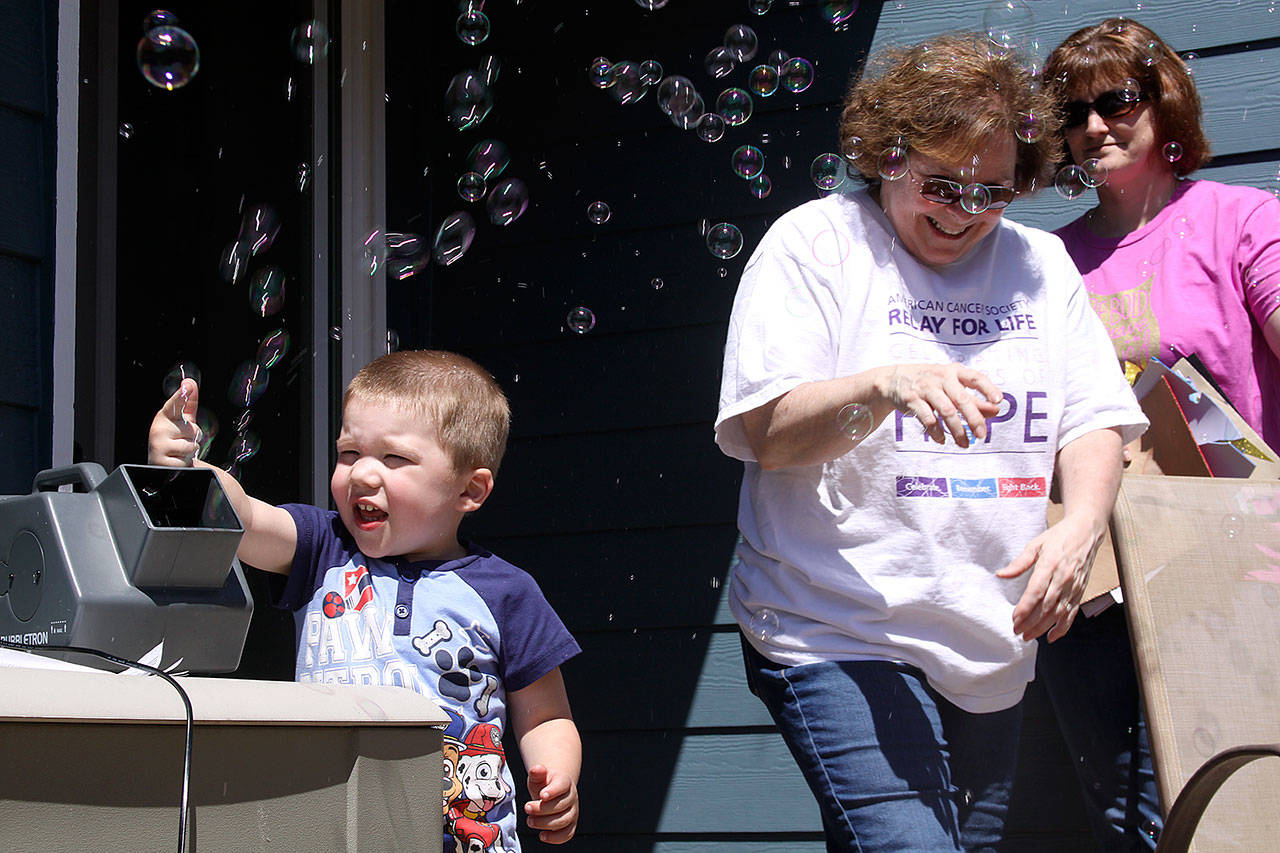Jackson Young is preparing for his second Relay for Life on Whidbey Island.
Since he’s only 3-and-a-half-years-old, he’s too young to understand what the event is all about. He just knows he gets to help his grandmother, which often means creating neat things at her house and, if he’s lucky, testing out the bubble blowing machine.
He got that chance Sunday on grandmother Karla Sharkey’s back porch in Oak Harbor. He watched in amazement as hundreds of bubbles filled the sky.
“He thinks this is fun and everything,” said Sharkey, one of the organizers of Relay for Life of Whidbey Island. “As they get older and understand and they learn things and hear things, it’s amazing what kids learn from cancer prevention and services. And it’s also learning how to be a volunteer.
“Last year he was helping clean up luminary bags and everybody said, ‘What are you doing?’ I said, ‘Veronica (Jackson’s mom) says we start them young here.’”
The Relay for Life of Whidbey Island is in its 30th year of raising awareness and money to aid in the fight against cancer. The event, a fundraiser for the American Cancer Society, starts at 6 p.m. Friday, June 2 on the track at North Whidbey Middle School and continues through noon Saturday.
Sharkey has been involved with the Oak Harbor event for 22 years. She is reminded why often when she hears her grandson say something that brings a smile to her face.
Such was the case Sunday when he pulled up a chair next to his grandmother and started munching on a bowl of watermelon wedges and she asked him if he wanted something else to eat.
“What about bubble machine?” he replied.
The bubble machine, she explained, was taking a nap. It needed its rest for the big event.
Sharkey’s own children never got a chance to meet their grandmother Lillian Sharkey, who died from cancer more than 30 years ago.
Sharkey’s mom, Miriam Kruse, also has battled cancer but is in remission.
It’s often a personal story that drives those involved with Relay for Life and keeps them coming back. Committee members start holding monthly leadership meetings in November. Sharkey and co-chair Mary Brock already have started planning for the 2018 event.
IDEX, Sharkey’s employer, has supported her involvement with the event all 22 years and annually produces the top fundraising team.
“I had the opportunity to go to Utah this year and was able to visit a hope lodge, which is sponsored by the American Cancer Society,” Sharkey said. “That’s where some of our Relay dollars go. And that was very impactful when you see people coming in from treatment that are really in bad shape and knowing that you’re making a difference in their lives.”
The Relay for Life of Whidbey Island has set a goal to raise $100,000 this year and has reached nearly $69,000 so far.
Participation has dipped in recent years, and getting new members to step forward to volunteer and help lead the charge has been a challenge.
“It’s really important to keep the blood pumping of Relay,” Sharkey said. “And in order to that we have to evolve and change with the times.”
About 40 teams will be involved this week. That number is less than half of the number of teams from just under a decade ago. Back then, the event raised more than $200,000.
But Whidbey’s event continues to be a significant money raiser and a model for other communities to follow.
“I think this year it doesn’t look like on paper that we have that many coming, but they will be there,” said Sandy Blondin, who serves as the survivors chairperson. “Our meeting haven’t been very big as they were in the past, but they’ll be there. People will come. You build it and people will come. You know how it works that way.”
Blondin should know. She attended the first Relay for Life event on Whidbey and has only missed one since.
She joked that she’ll never be able to leave the leadership group.
“They know where I live,” she said with a laugh.
A survivors lap at 6:20 p.m. is one of the early events that will begin Friday night’s schedule, followed by a caregivers lap.
New this year is an event designed to increase awareness about the American Cancer Society’s Road to Recovery program. There is a need for more drivers, who volunteer their time to give cancer patients rides to and from treatment.
At Relay for Life, teams will compete against each other racing cars made out of cardboard.
Judges will even critique the foot-powered vehicles.
“I can’t wait to see this car that IDEX is doing,” Sharkey said. “We have engineers building the car. You wouldn’t believe it. It’s so hilarious. It’s like, ‘Oh my goodness.’”
Relay for Life, which involves teams walking around the track through the night, won’t shut down until after the closing ceremony at noon Saturday.
Sailors from Electronic Attack squadrons 129 and 134 have stepped forward to help with the event’s extensive setup and tear down.
“I also ask myself the same thing every year: ‘Why do I do this?’” Sharkey said. “And this year I asked one of our team members at Holland Happening, and he said, ‘Well Karla, the reason we do this every year is so that researchers can do new treatments such as what I did and what I received. And I’m in remission.’
“In our society, less and less people volunteer. Even though it’s very tiring, the need is still there.
“Just recently I had an uncle that passed away from cancer… It’s everywhere. Even when people don’t think it is, it is everywhere.”
The public is invited to attend Relay for Life of Whidbey Island. Those wishing to support the cause may send a payment to: American Cancer Society, ATTN: Relay For Life of Whidbey Island, 3120 McDougall Ave. Suite 100, Everett, WA 98201.


